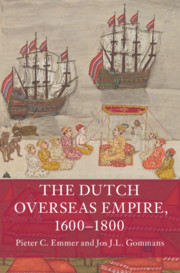Book contents
- The Dutch Overseas Empire, 1600–1800
- Additional material
- The Dutch Overseas Empire, 1600–1800
- Copyright page
- Contents
- Figures
- Cover Image
- Maps
- Note on Terminology
- Preface
- Frontispiece
- Introduction
- Part I The Grumbling Hive
- Part II The Atlantic World
- Part III Monsoon Asia
- Introduction
- 7 The Dutch Tropics
- 8 The Indian Ocean
- 9 The South China Sea
- Conclusion
- Coda
- References
- Index
Conclusion
from Part III - Monsoon Asia
Published online by Cambridge University Press: 29 September 2020
- The Dutch Overseas Empire, 1600–1800
- Additional material
- The Dutch Overseas Empire, 1600–1800
- Copyright page
- Contents
- Figures
- Cover Image
- Maps
- Note on Terminology
- Preface
- Frontispiece
- Introduction
- Part I The Grumbling Hive
- Part II The Atlantic World
- Part III Monsoon Asia
- Introduction
- 7 The Dutch Tropics
- 8 The Indian Ocean
- 9 The South China Sea
- Conclusion
- Coda
- References
- Index
Summary
Just how unique was the VOC in Asia? In attempting to answer this question, the first thing to establish is that the VOC did not act any more rationally than its Asian competitors. One crucial advantage it enjoyed was that its central organisation gave it a hitherto unparalleled trading network stretching from Amsterdam to Manila. This extensive network meant that the survival of the Company was not dependent on the events in any single region. Rather, it was the sum of a number of specific regional circumstances that contributed significantly to the Company’s success and decline. Apart from understanding these regional developments in their internal cohesion, it is also important to go back to the conclusions of Part I, to briefly reflect on the VOC’s economic performance, both overall and in comparison with its two main European rivals in Asia: the Portuguese Estado da India and the English East India Company. Let us start, though, by drawing some more general conclusions from the various regional chapters above, regarding, firstly, the Dutch settlement colonies in the Tropics and, secondly, the Dutch trading posts on the peripheries of the great Asian empires.
- Type
- Chapter
- Information
- The Dutch Overseas Empire, 1600–1800 , pp. 389 - 399Publisher: Cambridge University PressPrint publication year: 2020



